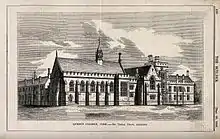Thomas Newenham Deane
Sir Thomas Newenham Deane (1828 – 8 November 1899) was an Irish architect, the son of Sir Thomas Deane and Eliza Newenham, and the father of Sir Thomas Manly Deane. His father and son were also architects.
Career
.jpg.webp)
Born in Cork, Thomas Newenham Deane joined his father's architecture practice in 1850.[1] In 1851, he became a partner along with Benjamin Woodward. Their work was primarily a Gothic style influenced by the principles of John Ruskin, and included the museum at Trinity College, Dublin, the Oxford University Museum of Natural History, the Pitt Rivers Museum,[2] the Kildare Street Club in Dublin, and Queen's College Cork, now University College Cork.[3] He was known as a conservation architect, involved in the restoration (including the incorporation of the original twelfth-century Romanesque chancel) of St Mary's Cathedral, Tuam.
His work on the conservation of St Canice's Cathedral, Kilkenny, was less successful and brought him into conflict with the dean and chapter, and in particular with the treasurer James Graves. It may have been due to his interest in the restoration of medieval buildings which led to his appointment as the first Inspector of National Monuments under the Irish Board of Works after the disestablishment of the Church of Ireland brought ruined buildings under their care. His work included St Cronan's Church of Ireland, Roscrea, County Tipperary.
In contemporary circles, Deane's partner Woodward was seen as the creative influence behind the business, and their practice suffered after his early death. Nevertheless, Deane continued to work with his son, Thomas Manly Deane, designing the National Museum of Ireland and National Library of Ireland in Kildare Street, Dublin. Thomas Newenham Deane was knighted in 1890.[1]

Personal life
On 29 January 1850, Deane married Henrietta Manly, daughter of Joseph H. Manly of Ferney, County Cork. Deane and his wife had several children. Deane died suddenly in Dublin on 8 November 1899.[4]
References
Notes
- Falkiner 1901.
- "Alterations & Improvements in Oxford". Jackson's Oxford Journal. 17 October 1885. p. 6 col A.
- O'Dwyer 1997.
- Irish Architectural Archive.
Sources
- O'Dwyer, Frederick (1997). The Architecture of Deane and Woodward. Cork. ISBN 0-902561-85-5.
- Lohan, Rena (1994). Guide to the archives of the Office of Public Works. Dublin. ISBN 9780707603797.
- Falkiner, Cæsar Litton (1901). . Dictionary of National Biography (1st supplement). London: Smith, Elder & Co.
- "Thomas Newenham Deane profile". Dictionary of Irish Architects. Irish Architectural Archive. Retrieved 24 July 2020.
